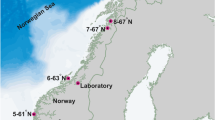Abstract
The rhodophyte Gracilaria tikvahiae is widely distributed along the eastern coast of the United States and has been considered a prime candidate for phycoculture for purposes including production of agar, bioconversion to methane, fertilizer, and sewage treatment (Ryther, DeBoer & Lapointe 1979; Ryther, Williams, Hanisak, Stenberg & DeBusk 1979; Bird et at. 1981; Hanisak 1981 a, b). Since 1975, G. tikvahiae has been cultivated at the Harbor Branch Institution in Fort Pierce, Florida, as part of a continuing program on seaweed mariculture. One focus of the research in this experimental system has been on manipulating environmental factors that can readily be controlled on a larger, commercial scale (e.g., nutrient enrichments and flow rates of seawater, but not light, temperature, and salinity). This communication will briefly review some of the findings of this research, with an emphasis on how the biology of G. tikvahiae interacts with the environmental conditions of the cultivation system.
Access this chapter
Tax calculation will be finalised at checkout
Purchases are for personal use only
Preview
Unable to display preview. Download preview PDF.
Similar content being viewed by others
References
Bird, K. T., M. D. Hanisak & J. H. Ryther, 1981. Changes in agar and other chemical constituents of the seaweed, Gracilaria tikvahiae. when used as a substrate in methane digesters. Resour. Conserv. 6: 321–327.
Blinks, L. R., 1963. The effect of pH upon the photosynthesis of littoral marine algae. Protoplasma 57: 126–136.
Chapman, A. R. O. & J. S. Craigie, 1977. Seasonal growth by Laminaria longicruris: relations with dissolved inorganic nutrients and internal reserves of nitrogen. Mar. Biol. 40: 197–205.
Hanisak, M. D., 1978. Cultivation and bioenergetics of the agarophyte Graci/aria tikvahiae. Int. Coun. Explor. Sea, Code Number C.M. 1979/F:24: 8 pp.
Hanisak, M. D., 1979. Nitrogen limitation of Codium fragile ssp. tomentosoides as determined by tissue analysis. Mar. Biol. 50: 333–337.
Hanisak, M. D., 1981a. Methane production from the red seaweed Gracilaria tikvahiae. Proc. int. Seaweed Symp. 10: 681–686.
Hanisak, M. D., 1981b. Recycling the residues from anaerobic digesters as a nutrient source for seaweed growth. Bot. mar. 24: 57–61.
Huguenin, J. E., 1976. An examination of problems and potentials for future large-scale intensive seaweed culture systems. Aquaculture 9: 313–342.
Lapointe, B. E. & J. H. Ryther, 1978. Some aspects of the growth and yield of Gracilaria tikvahiae in culture. Aquaculture 15: 185–193.
Lapointe, B. E. & J. H. Ryther, 1979. The effects of nitrogen and seawater flow rate on the growth and biochemical composition of Gracilaria foliifera var. angustissima in mass outdoor culture. Bot. mar. 22: 529–537.
Neish, A. C., P. F. Shacklock, C. H. Fox& F. J. Simpson, 1977. The cultivation of Chondrus crispus: Factors affecting growth under greenhouse conditions. Can. J. Bot. 55: 2263–2271.
Ryther, J. H., N. Corwin, T. A. DeBusk & L. D. Williams, 1981. Nitrogen uptake and storage by the red alga Gracilaria tikvahiae (McLachlan, 1979). Aquaculture 26: 107–115.
Ryther, J. H., J. A. DeBoer & B. E. Lapointe, 1979. Cultivation of seaweeds for hydrocolioids, waste treatment, and biomass for energy conservation. Proc. int. Seaweed Symp. 9: 1–17.
Ryther, J. H. & T. A. DeBusk, 1982. Significance of carbon dioxide and bicarbonate-carbon uptake in marine biomass production. Presented at the Symposium ‘Energy from Biomass and Waste VI’. January 25–29, 1982. Lake Buena Vista, Florida.
Ryther, J. H., T. A. DeBusk, D. A. Andrews & C. Habig, 1983. Cultivation of Gracilaria as a biomass source for energy. Proc. World Mariculture Soc. (In press).
Ryther, J. H., L. D. Williams, M. D. Hanisak, R. W. Stenberg & T. A. DeBusk, 1979. Biomass production by marine and freshwater plants. Third Annual Biomass Energy Systems Conf. Proc. Solar Energy Res. Inst., Golden, Colorado: 13–23.
Author information
Authors and Affiliations
Editor information
Editors and Affiliations
Rights and permissions
Copyright information
© 1984 Dr W. Junk Publishers, Dordrecht
About this paper
Cite this paper
Hanisak, M.D., Ryther, J.H. (1984). Cultivation biology of Gracilaria tikvahiae in the United States. In: Bird, C.J., Ragan, M.A. (eds) Eleventh International Seaweed Symposium. Developments in Hydrobiology, vol 22. Springer, Dordrecht. https://doi.org/10.1007/978-94-009-6560-7_57
Download citation
DOI: https://doi.org/10.1007/978-94-009-6560-7_57
Publisher Name: Springer, Dordrecht
Print ISBN: 978-94-009-6562-1
Online ISBN: 978-94-009-6560-7
eBook Packages: Springer Book Archive




